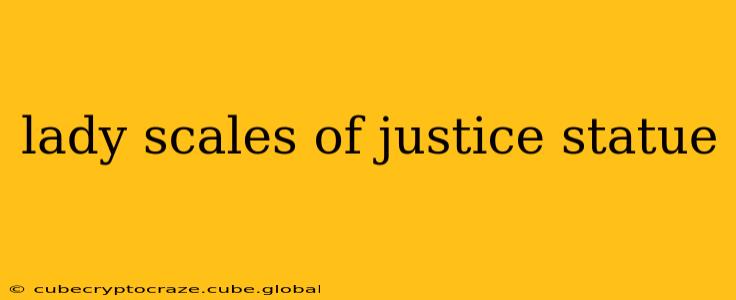The iconic image of Lady Justice, a blindfolded woman holding scales and a sword, is a powerful symbol representing the ideals of justice systems worldwide. But what does this statue truly represent, and what's the story behind its enduring presence in courtrooms and legal settings? This article delves into the rich history and symbolism of Lady Justice, exploring its multifaceted meaning and addressing common questions surrounding this important figure.
What does the Lady Justice statue symbolize?
The Lady Justice statue, also known as Justitia, embodies several key principles fundamental to a fair and impartial legal system. The scales represent the weighing of evidence, the impartial assessment of facts, and the balanced consideration of all sides in a legal dispute. The blindfold signifies impartiality and objectivity, emphasizing that justice should be administered without bias or prejudice, regardless of wealth, status, or personal beliefs. Finally, the sword symbolizes the power of the law, the authority to enforce decisions, and the potential for punishment when justice is violated. In short, the statue represents the pursuit of truth, fairness, and equitable application of the law.
What is the history of Lady Justice?
The figure of Lady Justice has ancient roots, drawing inspiration from various goddesses and figures across different cultures. While the modern depiction is largely associated with Western legal traditions, its origins can be traced back to ancient Greek and Roman mythology. The Roman goddess Justitia is considered a primary influence, with depictions often featuring attributes similar to the modern Lady Justice statue. Over time, these elements evolved and were integrated into the Christian tradition, where depictions of justice became more widely adopted. The current widespread usage of the statue largely solidified during the Enlightenment and the rise of modern legal systems.
What are the different interpretations of Lady Justice?
While the core symbolism remains consistent, interpretations of Lady Justice can vary across different contexts and cultures. Some emphasize the statue's representation of divine justice, highlighting a higher moral authority overseeing the legal proceedings. Others focus on the human aspect, portraying Lady Justice as a symbol of striving for fairness and equity within the limitations of human justice systems. The meaning can also be influenced by the specific artistic rendition of the statue, with variations in dress, pose, and the presence or absence of certain attributes affecting its overall interpretation.
What does the blindfold on Lady Justice mean?
The blindfold on Lady Justice is perhaps the most recognizable and debated aspect of the statue. It unequivocally represents impartiality and the concept of justice being blind to personal characteristics. The blindfold signifies that judgments should be based solely on the merits of the case, uninfluenced by factors such as race, gender, social status, or personal connections. It's a visual reminder that the pursuit of justice requires setting aside personal biases and adhering strictly to the evidence presented.
What does the sword in Lady Justice's hand represent?
The sword held by Lady Justice signifies the power of the law and its ability to enforce judgments. It represents the authority to uphold justice and the potential for punishment when laws are broken. It's a symbol of the legal system's capacity to act decisively and to ensure that justice is not merely abstract but a tangible force within society. While the sword represents strength and authority, it should be wielded judiciously and in accordance with the principles of justice that the scales embody.
Why is Lady Justice depicted as a woman?
The depiction of Lady Justice as a female figure is not without its complexities and interpretations. Historically, feminine qualities like compassion, empathy, and nurturing have been associated with justice. However, the choice of gender also reflects the historical power dynamics and societal norms prevalent during the periods when the iconography developed. Discussions about the representation of Lady Justice often consider the historical context, as well as ongoing dialogues about gender equality and appropriate representation in legal systems and broader society.
Conclusion: The Enduring Symbol of Lady Justice
The Lady Justice statue is more than just a decorative element; it serves as a potent reminder of the ideals upon which just and equitable legal systems aspire to operate. Its enduring presence in courtrooms and legal settings worldwide underscores the ongoing importance of impartiality, fairness, and the balanced application of the law. By understanding the multifaceted symbolism embedded within this iconic figure, we gain a deeper appreciation for the pursuit of justice itself.
